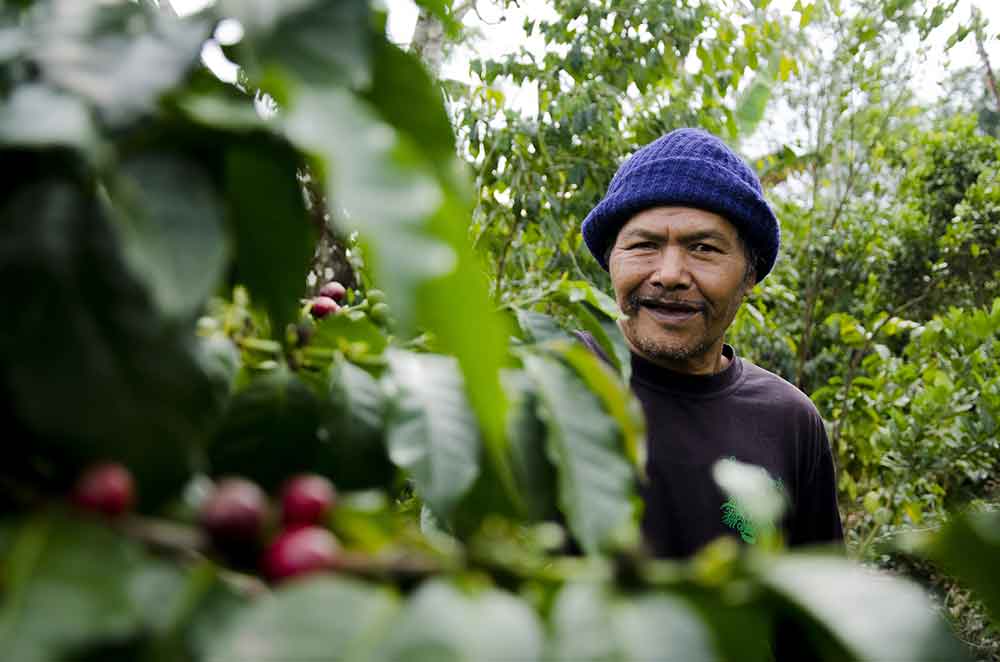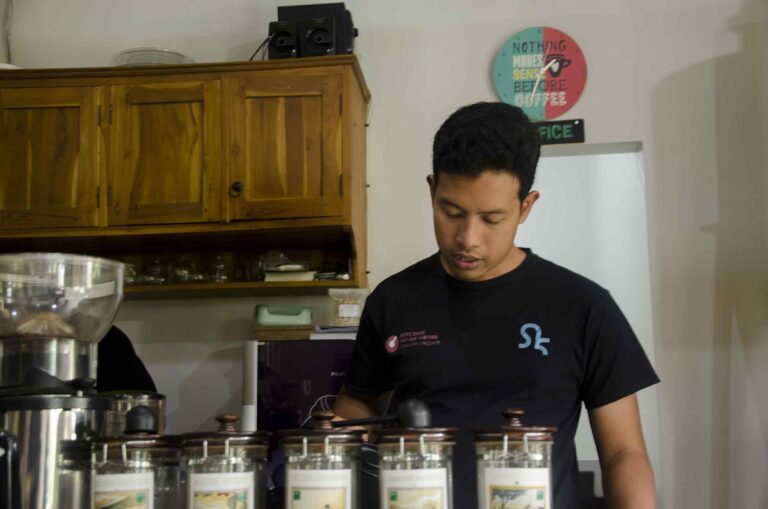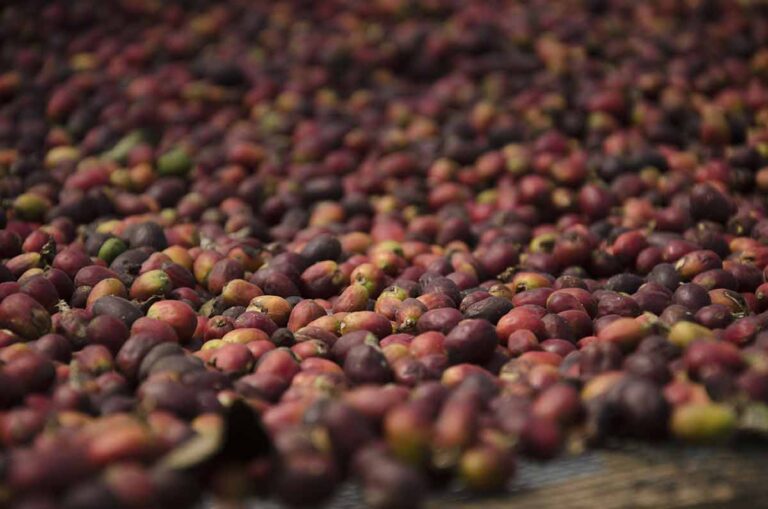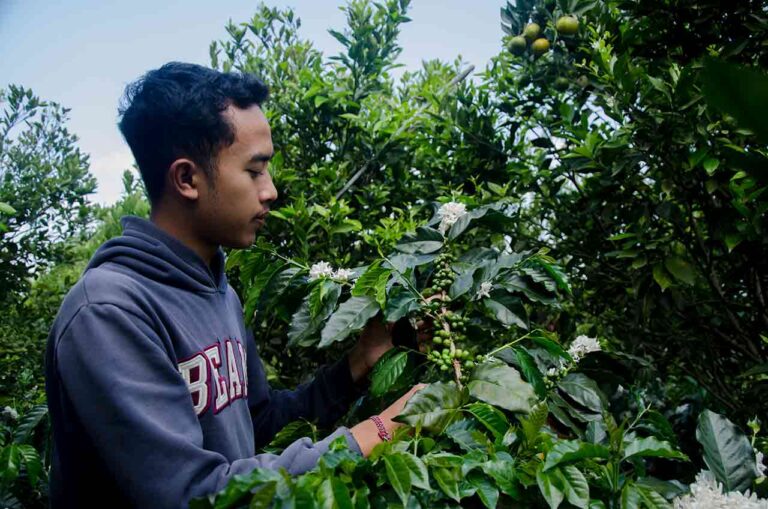The roaring sound of the espresso machine interrupted our morning chat in the living room. Soon, Ketut Jati approached us with two cups of Americano coffee that spread the delicious aroma of Kintamani Arabica coffee.
“Next time you come here when I’m not here, make the coffee yourself,” he said as he offered two more cups to two other guests sitting across the table.
“Next time, I’ll brew coffee for Mr. Jati,” I replied with a grimace.
It was an honor to be served coffee from the maestro of Kintamani Arabica specialty coffee.
I Ketut Jati is a coffee farmer who knows well the history of Kintamani Coffee. How it went from being a low-value crop to a world-renowned commodity.
Graduating from high school in Singaraja in 1985, he decided to return home to Catur Village, Kintamani, Bangli. I Ketut Jati chose to return home to help his parents tend their garden.
The family’s five hectares of land were partly planted with coffee, which often yielded meager harvests. In addition to the traditional farming pattern, the infrastructure in the Kintamani area is not yet adequate, as there is no direct road to the city of Denpasar.
Although the Bali Provincial Plantation Office has distributed free coffee seeds to many farmers in Kintamani since 1975, the yields have not changed the fate of farmers for the better.
The economy of the Kintamani community began to improve in 1990. The Kintamani market was built, and paved roads reached more distant areas. The Tukad Bakung Bridge, which is the main link between Catur Village and Plaga, was built in 2000.
Assistance from Puslitkoka
Facilitated by the Plantation Office, the Jember Coffee and Cocoa Research Center (Puslitkoka) provided assistance to coffee farmers in Kintamani in 2000.
From gardening patterns to harvesting to processingcrops, it is not easy to change the coffee farming methods of people who have inherited the old ways from their ancestors.
“I approached farmers one by one, inviting them to change the way they harvest. Pick only the red coffee fruit, not the knitting pattern anymore,” recalls I Ketut Jati.
Knitting is picking not only the red, ripe coffee fruit but also the green, unripe fruit. But slowly, Kintamani coffee farmers began to follow a better farming pattern. The harvest of a good garden was not immediately easy to market at a good price.
At first, in 2008, Puslitkoka accommodated the harvest of farmers who had switched to this new pattern. It did not take too long before the name Kintamani Arabica coffee began to be recognized as a coffee of good quality.

Geographical Indication of Kintamani Arabica Coffee
Puslitkoka, together with researchers from the French Agricultural Research Center (CIRAD), conducted a consistency test of Kintamani Arabica coffee characteristics from the harvest each year. From 2003 to 2007, the results were consistent.
The results of the consistency test of Kintamani Arabica coffee characteristics were then submitted to the Ministry of Law and Human Rights (Kemenkum HAM) to obtain geographical indication (GI) certification.
While continuing to organize institutions at the farm level with farmers in Subak Abian, which is a combination of Kintamani District, Bangli; Petang District, Badung; and Sukasada District and Sawan District, Buleleng, so that Kintamani Arabica coffee cultivation patterns can also be organized more systematically and maintained.
Finally, in 2008, the Ministry of Law and Human Rights issued a Geographical Indication certification for Kintamani Arabica Coffee. This made it easier for Kintamani Coffee to gain popularity in the specialty coffee commodity market.
The excitement of the new status as a coffee-producing area with IG certification made the Kintamani coffee stakeholders agree to help the Geographical Indication Protection Society (MPIG). The harvest of Kintamani coffee farmers is no longer difficult to market.
Through cooperatives that also cooperate with coffee processing companies such as PT Indo Cafco and PT Delta, hundreds of tons of rice coffee were successfully marketed to these two companies.
But with the passage of time, it seems that the coveted status as a region with coffee products that have IG certification does not go hand in hand with the sustainability of the institutional side of the farmers. MPIG and MPIG cooperative organizations have begun to lack activity. This fading organization clearly concerned I Ketut Jati.
“I did resign from the position of Chairman of MPIG because I felt it was time for the younger generation to continue,” he said.
Currently, I Ketut Jati is busy taking care of 20 hectares of coffee plantations and a coffee harvest processing factory. He processes no less than 170 tons of coffee beans a year.
“I just hope that the quality and good name of Kintamani Coffee will be maintained. I don’t know how to do it anymore if the farmer groups have gone their own way,” he concludes.
I Ketut Jati’s Americano coffee has been sipped. The distinctive flavor of Kintamani coffee slid smoothly away. But Kintamani must not lose its flagship coffee.



